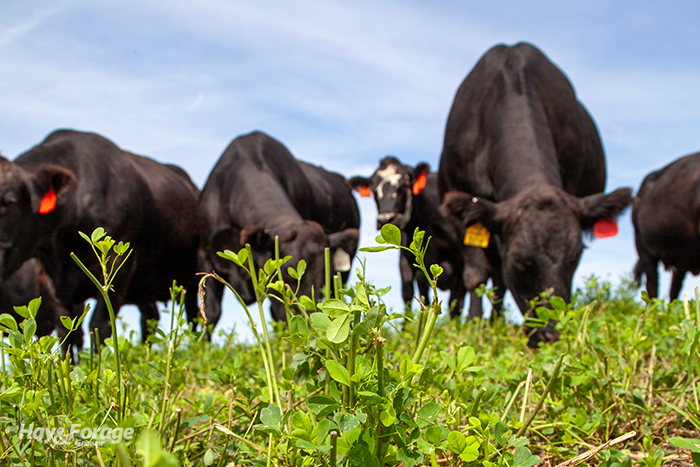
Alfalfa hasn’t earned its reputation as a foundational forage resource as a grazing crop. It’s been more so as a conventionally harvested crop. Still, there is no hard and fast rule that states alfalfa can’t be grazed, and there are many livestock producers who find it to be a valuable pasture forage, either in pure stands or mixed with other grass and/or legume species.
Alfalfa benefits pastures by being a prolific nitrogen fixer, offering good yields in both dry and wet time periods, and providing an excellent protein and energy source.
The primary reason why many livestock producers stay away from alfalfa in their pastures is because of bloat risk, according to information provided by the Canadian Beef Cattle Research Council (BCRC). Respect it, but don’t fear it, is the advice offered by both cattle producers and beef specialists who, through years of experience and research, appreciate the value of grazing cattle on pure or percentage stands of alfalfa.
Even proponents of alfalfa grazing recognize that bloat deserves attention, but they find relatively easy ways to manage around it. The BCRC offers the following recommendations to help mitigate frothy bloat problems when grazing alfalfa:
1. Avoid moving cattle onto new pasture when it’s wet with heavy dew, rainfall, or irrigation water. Grazing alfalfa when it is wet enhances the possibility of bloat.
2. Make paddock rotations mid-day or later to help minimize moisture. Plants will also have a higher plant carbohydrate concentration in the afternoon.
3. Do not allow animals to stand hungry before turning them into an alfalfa pasture, as this can lead to overconsumption of fresh alfalfa and raise the risk of bloat.
4. Fill animals with dry hay or grass pasture before beginning to graze high bloat-potential pastures. Fibrous hay can also be offered while cattle are grazing alfalfa.
5. Wait until alfalfa is flowering to graze. Bloat risk is highest when alfalfa is in vegetative and bud stages of growth. As alfalfa enters the flowering stages, the alfalfa becomes more fibrous and the rate of digestion slows down.
6. Once grazing begins, don’t remove animals from pasture or make frequent, major changes in the type of pasture being grazed unless animals have greatly distended rumens. Mild bloat is common on high bloat-potential pastures. Frequent diet changes prevent rumen microbes and animals from adapting to bloat pastures.
7. Do not graze alfalfa for three days to two weeks following a killing frost. Frost may enhance the incidence of bloat by rupturing plant cell walls, leading to a high initial rate of digestion. Delay grazing alfalfa until the stand dries.
8. Monitor cattle frequently for condition and any signs of bloat or sickness. Adjust grazing plans if needed.
9. Graze with animals that have smaller rumen capacities, like yearlings and calves, rather than mature cows.
10. Talk to your veterinarian about the advisability of using a bloat preventative product.
Seeding alfalfa in a pasture forage mix can raise the fiber level of the overall pasture. This can also reduce the risk of bloating.
Both grazing management and variety will dictate alfalfa’s tolerance to grazing. Alfalfa needs to be provided a rest period, so using a type of rotational system is advantageous. Also, some alfalfa varieties are more tolerant to grazing than others. These types tend to have submerged crowns and branched roots.

